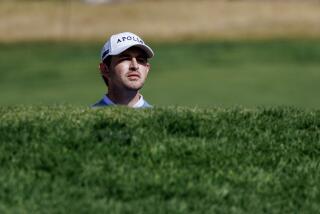Getting Children Hooked on Golf
- Share via
Barking directions in his best drill sergeant voice, Mike Williams quickly has the two dozen youngsters standing silently and at attention in a single line.
“Those who don’t want to be here, who don’t like it, tell me upfront so that we won’t waste time,” Williams tells the group of sixth- and seventh-graders from Henry Clay Middle School.
No one steps forward.
Williams, head pro at the county’s 18-hole Chester L. Washington golf course, then talks about etiquette and safety, about how serious an injury a golf club can inflict.
“If I see anyone slam this club on the ground, that’s the end of your being in this class,” he says. “One thing you must know. This is a game of patience and quiet.”
A lean 6-footer with an otherwise easy manner, Williams is a fixture at the course nestled between Gardena and Inglewood, just south of South-Central Los Angeles.
Long before there was a Tiger Woods rewriting scoring records in professional golf, Williams, 53, was toiling away at Chester Washington, teaching youngsters who might otherwise never have been exposed to the royal and ancient game.
Woods, who grew up in Orange County, used to stop by the course, dazzling veteran golfers with his skill, competing in junior tournaments and picking up playing tips from the pros.
With Woods’ emergence as golf’s dominant player, interest in the game has never been greater, especially among minority kids who may not have been able to afford to play or who dismissed the game as not being “cool.” Tiger Woods has made it cool.
In the 17 years Williams has been at Chester Washington, he estimates that thousands of youngsters have come through various junior golf programs he has taught there.
“He goes into his own pockets to help kids with equipment,” says Frank Snow, a former teaching pro and one of the regulars at Chester Washington. “He does that all the time.”
For years, children in the unincorporated Athens area, near Western Avenue and 120th Street where the course sits, would climb a fence to make off with golf balls, Williams says.
“They had no clue what was going on here,” Williams says. “I would tell them to bring their friends. I would teach them golf, but on one condition: Don’t steal our balls.”
When he is not reaching into his wallet for those youngsters, Williams is a master at scrounging up clubs for them from golfers who are more than willing to help junior golf.
“Of all the guys around, he’s the top at teaching kids,” Snow says. “I don’t have the patience to handle kids the way he handles them. A lot of pros don’t.”
Williams may put his game face on for youngsters, but regulars at the course say he is absolutely committed to the kids.
“When everybody else is ready to give up, he somehow turns that kid on to the game,” says Marilyn Evans, assistant director of the Young Golfers of America Assn., a group that sponsors free lessons for youngsters like those from Clay Middle School.
“He’ll tell me, ‘Marilyn, everybody says he won’t be a golfer. But he’s enjoying it, and I’m going to work with him.’ ”
Evans’ response: “All right, Mr. Tough Guy.”
While Evans’ program is free, youngsters can enroll in others with Williams and his staff for as little as $25 a year.
Williams works for American Golf Corp., which runs the course under contract to the county, and the company charges junior golfers nominal amounts for range balls and greens fees.
Chris Whittaker, 19, a scratch golfer who attends West Los Angeles College, took his first lessons from Williams 10 years ago and knows how dedicated the pro is to youngsters.
Graduates Have Gone on to Success
“He really cares,” says Whittaker, once an internationally ranked junior player who hopes to eventually turn pro. “He was always there to help me, even when he was busy. Whenever I needed balls or gloves, he would give them to me.”
Evans says she has seen youngsters’ grades and golf games improve because Williams was there for them. Dozens of the program’s graduates have won college golf scholarships, and the instruction has been the main reason that some schools, such as Washington High, have been able to keep their golf teams, Evans says.
Williams, a PGA pro, has also been there for those youngsters who don’t come to him through any organized program.
After impressing the Clay Middle School students with the importance of safety and etiquette, Williams moves on to teaching them the parts of a golf club and introducing them to fundamentals: grip, stance, posture.
When they take their first swings, most of their shots barely dribble off the tee.
“I told you this is not easy,” Williams tells a youngster.
“Don’t look at me, son,” he tells another. “Look at the golf ball.”
Nearly all of the Clay youngsters are trying golf for the first time. But there are a few ringers.
Sean Lucas, 11, began with Williams and has been playing for more than a year. He steps up to the tee and hits a shot with a six iron, sending it about 140 yards in a graceful arc.
“My friends think golf is boring,” Sean says after hitting several shots. “I try to explain that it’s really fun. Most people I talk to don’t know any golfers except Tiger Woods.”
In the short time he’s been playing, Sean has already captured a championship trophy with a 1-over-par round at the Maggie Hathaway Par 3 course in South-Central.
Ana Flores, 13, and her friend Daisy Corral, 12, began with Williams last year and have caught the bug. “I had thought about playing golf,” Daisy says. “I had seen it on TV. It took a few weeks before I could hit the ball.”
For most youngsters in the class, golf is still a game beyond their means. They can’t afford to buy clubs.
They come to Williams’ class as part of Evans’ Young Golfers of America, and youngsters who show enough promise eventually get a chance to move up to an intermediate or advanced group and are given a set of clubs.
“They come, leave, come back,” Evans says. “Some realize they’re not built for basketball or football. This is something they can do.”
No matter how frustrated a youngster may become over not being able to even make contact with the ball, Williams and the five pros who assist him offer encouragement.
And Williams occasionally passes along fashion tips.
“What did I tell you about those pants, young man,” he says to a youngster whose beltless jeans are sagging down off his hips. “You might hit the ball if you wore a belt.”
As he wraps up the lesson, he takes a club and gives the youngsters a sense of what they might be able to do if they stick with the game.
With a swing as smooth as a knife cutting through warm butter, he hits shot after graceful shot. The students, even those who have seen him hit before, stand in awe as the six-iron shots soar 170 yards, moving gently from right to left in a controlled draw.
The youngsters are mesmerized, but Williams eventually breaks the spell, telling them with a satisfied twinkle in his eye: “See you next week.”
More to Read
Go beyond the scoreboard
Get the latest on L.A.'s teams in the daily Sports Report newsletter.
You may occasionally receive promotional content from the Los Angeles Times.










